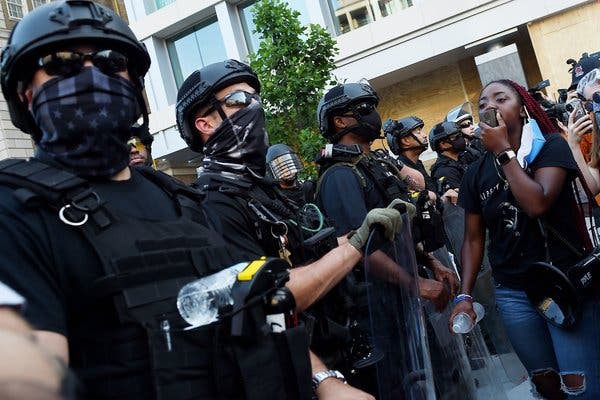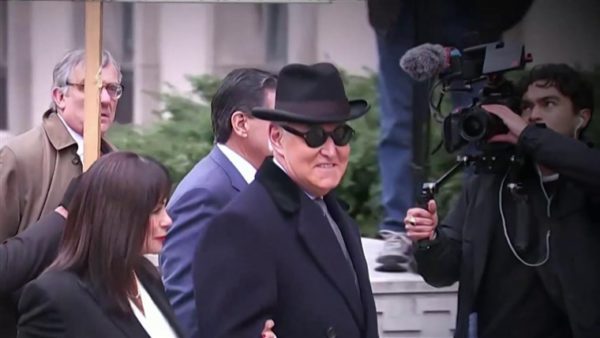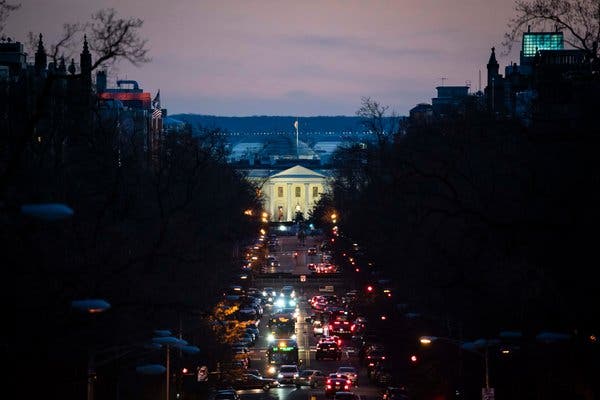Advertisement
The Trump administration has deployed phalanxes of officers in riot gear and no identifiable markings to police demonstrations in the capital. Democrats want to know who they are.

WASHINGTON — The Trump administration’s aggressive deployment of officers donning riot gear with no identifiable markings has increased tensions with protesters, raised the specter of a “secret police” force and prompted Speaker Nancy Pelosi to demand that President Trump identify the federal forces he has put on the streets of the capital.
Demonstrators in downtown Washington say federal officers in generic riot gear have refused to identify themselves or display identifying features, and the deployment of federal law enforcement is supposed to get even larger this weekend.
Congressional Democrats say the administration’s use of ambiguous tactical teams is infringing on the rights of the protesters. Senators Chuck Schumer of New York, the Democratic leader, and Christopher S. Murphy, Democrat of Connecticut, introduced legislation mandating that law enforcement officers and members of the armed forces identify themselves and their agency.
In a letter to Mr. Trump on Thursday, Ms. Pelosi asked for details identifying the law enforcement and military agencies that had been deployed across the capital to police the protests.
“The practice of officers operating with full anonymity undermines accountability, ignites government distrust and suspicion, and is counter to the principle of procedural justice and legitimacy during this precarious moment in our nation’s history,” Ms. Pelosi wrote.
The question over the federal law enforcement practices comes as Attorney General William P. Barr has flooded Washington with agents from the F.B.I., the Bureau of Alcohol, Tobacco, Firearms and Explosives, the Department of Homeland Security and the Bureau of Prisons — an agency that House Democrats said in a letter to Mr. Barr was responsible for sending the unidentifiable officers.
Mr. Barr on Wednesday night further empowered those teams from the Bureau of Prisons with the authority to make arrests at the demonstrations.
Even as federal troops on Thursday retreated from the area in front of Lafayette Square, which is controlled by the federal government, and Mr. Barr said he could reduce the number of security checkpoints after “a sharp reduction in violent episodes,” officials familiar with the deployment said an even larger federal presence and aggressive crackdown was expected this weekend when thousands of additional protesters were anticipated to march on the nation’s capital.
“The United States would normally condemn this tactic if used by dictators of other countries, and its use here directly threatens our democracy,” Mr. Murphy said. “Americans have a right to know who is patrolling their streets, and to have recourse if their massive power is misused.”
Historically, local police departments have required their officers to have some sort of identification on their uniforms, according to Chuck Wexler, the executive director of the Police Executive Research Forum, a research organization. The Justice Department criticized the Police Department in Ferguson, Mo., six years ago for not forcing officers to display signs identifying their department. But lawyers have found that state and federal laws do little to require that law enforcement agencies identify themselves to the public.
Identification gets even more difficult at the federal level, said Carl Takei, a senior staff lawyer at the American Civil Liberties Union who focuses on law enforcement.
Mr. Takei said the use of teams from the Bureau of Prisons particularly hindered efforts to identify officers and de-escalate encounters. Each of the agencies deployed relies on different internal policies and on varied sets of rules. The Bureau of Prisons may be especially out of its depth: Responding to a peaceful demonstration requires a different response than stopping a prison riot.
“To transport this prison S.W.A.T. team into a position where they’re in a position to manage a protest involving thousands of people, it’s just such a radically different context,” Mr. Takei said. “That issue is particularly dangerous, not being able to clearly identify them as being federal agents based on the way that they’re labeled. It’s deeply irresponsible on the part of the superior officer to not tell them to wear identifying insignia.”
The Bureau of Prisons did not respond to requests for comment. Justice Department officials told reporters on Thursday that they were not aware of officers refusing to be identified. Asked about increasing the presence of tactical teams over the weekend, Alexei Woltornist, a spokesman for the Department of Homeland Security, said the agency did not comment “on active or tentative operational status of its front-line workers for their protection.”
J. Peter Donald, a former assistant commissioner of the New York Police Department who also worked for the F.B.I., said it was crucial that law enforcement “use every opportunity” to build meaningful relationships with the public. “Certainly knowing who you’re talking to is an important piece of that,” he said.
State and local officials have also had mixed reactions to the deployments. Even as Maryland’s governor, Larry Hogan, approved the sending of National Guard troops to Washington on Wednesday, the city’s mayor, Muriel E. Bowser, said the federal presence was unwelcome. Ms. Bowser, who on Thursday said she had spoken to Ms. Pelosi about the federal agents and troops in Washington, said she wanted them removed from the city.
“The first thing is we want the military, we want troops from out of state out of Washington, D.C.,” Ms. Bowser said.
Demonstrators say the anonymous officers have also prompted fears that members of militias could be entering protests unnoticed. Protests were largely peaceful on Wednesday, particularly when the demonstration moved away from Lafayette Square. But hostility grew when demonstrators returned downtown and were faced with the line of federal troops.
Ben Davis, a 23-year-old graduate of American University, attended the protest in Washington on Wednesday and was surprised to see a line of officers with unmarked riot gear standing in front of members of the National Guard.
“There was just no way to identify who these people were or who they were working for,” Mr. Davis said.
“God forbid if there’s an escalation of violence and there’s a video circulating of an officer using his baton on a protester, and there’s no way to identify who that officer is,” Mr. Davis said. “That’s what I’m concerned about.”
Katie Benner contributed reporting.



